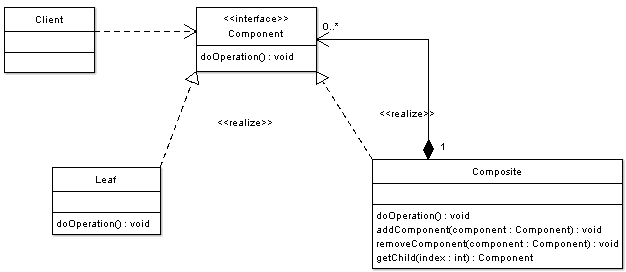Introduction
Composite pattern is used where we need to treat a group of objects in similar way as a single object. Composite pattern composes objects in term of a tree structure to represent part as well as whole hierarchy. This pattern creates a class that contains group of its own objects. This class provides ways to modify its group of same objects. Consider for example a program that manipulates a file system. A file system is a tree structure that contains branches which are folders as well as leaf nodes which are files. Folder object usually contains one or more file or folder objects and thus is a complex object where a file is a simple object. Since files and folders have many operations and attributes in common, such as moving and copying a file or a folder, listing file or folder attributes such as file name and size, it would be easier and more convenient to treat both file and folder objects uniformly by defining a File System Resource Interface.
Intent
- Compose objects into tree structures to represent whole-part hierarchies. Composite lets clients treat individual objects and compositions of objects uniformly.
- Recursive composition
Implementation
It has four participants:
- Component is the abstraction for leafs and composites. It defines the interface that must be implemented by the objects in the composition.
- Leafs are objects that have no children. They implement services described by the Component interface.
- Composite stores child components in addition to implementing methods defined by the Component interface. Composites implement methods defined in the Component interface by delegating to child components.
- Client manipulates the objects in the composition through the component interface.
Example
// Composite Design Pattern example of a company with different employee details
// A common interface for all employee
interface Employee
{
public void showEmployeeDetails();
}
class Developer implements Employee
{
private String name;
private long empId;
public Developer(long empId, String name)
{
this.empId = empId;
this.name = name;
}
@Override
public void showEmployeeDetails()
{
System.out.println(empId+" " +name);
}
}
class Manager implements Employee
{
private String name;
private long empId;
public Manager(long empId, String name)
{
this.empId = empId;
this.name = name;
}
@Override
public void showEmployeeDetails()
{
System.out.println(empId+" " +name);
}
}
// Class used to get Employee List and do the opertions like add or remove Employee
class CompanyDirectory implements Employee
{
private List<Employee> employeeList = new ArrayList<Employee>();
@Override
public void showEmployeeDetails()
{
for(Employee emp:employeeList)
{
emp.showEmployeeDetails();
}
}
public void addEmployee(Employee emp)
{
employeeList.add(emp);
}
public void removeEmployee(Employee emp)
{
employeeList.remove(emp);
}
}
// Driver class
public class Company
{
public static void main (String[] args)
{
Developer d1 = new Developer(100, "Lokesh Sharma");
Developer d2 = new Developer(101, "Vinay Sharma");
CompanyDirectory engDirectory = new CompanyDirectory();
engDirectory.addEmployee(d1);
engDirectory.addEmployee(d2);
Manager m1 = new Manager(200, "Kushagra Garg");
Manager m2 = new Manager(201, "Vikram Sharma ");
CompanyDirectory accDirectory = new CompanyDirectory();
accDirectory.addEmployee(m1);
accDirectory.addEmployee(m2);
CompanyDirectory directory = new CompanyDirectory();
directory.addEmployee(engDirectory);
directory.addEmployee(accDirectory);
directory.showEmployeeDetails();
}
}

